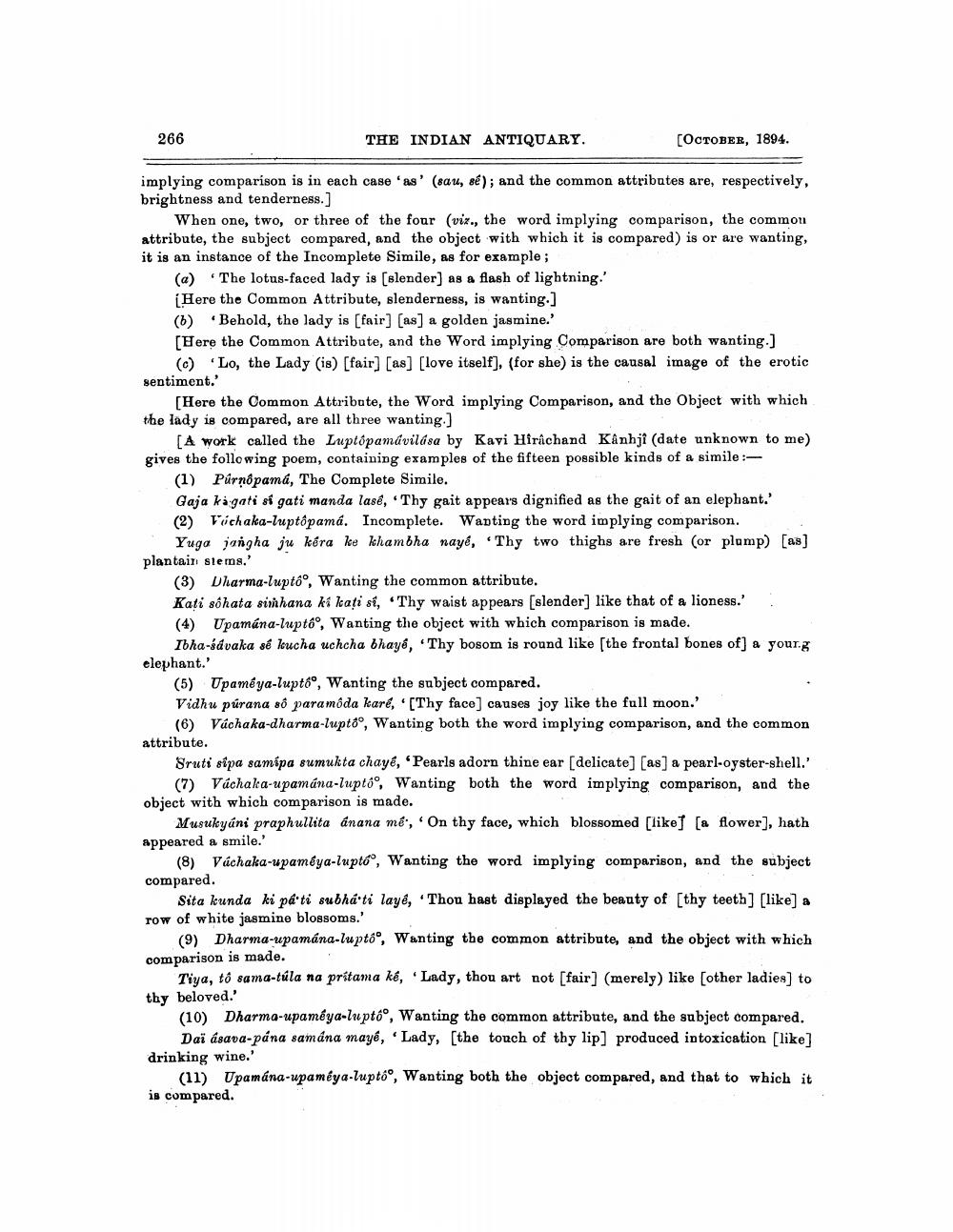________________
266
THE INDIAN ANTIQUARY.
[OCTOBER, 1894.
implying comparison is in each case 'as' (sau, sé); and the common attributes are, respectively, brightness and tenderness.]
When one, two, or three of the four (viz., the word implying comparison, the common attribute, the subject compared, and the object with which it is compared) is or are wanting, it is an instance of the Incomplete Simile, as for example;
(a) The lotus-faced lady is (slender) as a flash of lightning.' Here the Common Attribute, slenderness, is wanting ] (6) Behold, the lady is [fair] [as] a golden jasmine.' [Here the Common Attribute, and the Word implying Comparison are both wanting.)
(c) 'Lo, the Lady (is) [fair) [as] [love itself], (for she) is the causal image of the erotic sentiment.'
[Here the Common Attribute, the Word implying Comparison, and the Object with which the lady is compared, are all three wanting]
[A work called the Luptopamávilása by Kavi Hirâchand Kanhji (date unknown to me) gives the following poem, containing examples of the fifteen possible kinds of a simile:
(1) Púrnôpamá, The Complete Simile. Gaja kågati si gati manda lase, Thy gait appears dignified as the gait of an elephant.' (2) Vichaka-luptôpama. Incomplete. Wanting the word implying comparison.
Yugo jangha ju kôra ke khambha nayé, Thy two thighs are fresh (or plump) [as] plantain slems.'
(3) Dharma-luptó°, Wanting the common attribute. Kati sôhata sirhana ki kați si, Thy waist appears [slender] like that of a lioness. : (4) Upamána-luptoo, Wanting the object with which comparison is made.
Ibha-śdvaka se lucha uchcha bhaya, Thy bosom is round like (the frontal bones of] a yourg elephant.'
(5) Upaméya-luptó, Wanting the subject compared. Vidhu púrana sô paramôda karé, *[Thy face) causes joy like the full moon.'
(6) Váchaka-dharma-luptoo, Wanting both the word implying comparison, and the common attribute.
Sruti sipa samipa sumukta chayé, 'Pearls adorn thine ear (delicate] [as] a pearl-oyster-shell.'
(7) Váchalia-upamána-luptó, Wanting both the word implying comparison, and the object with which comparison is made.
Musukyáni praphullita anana me, On thy face, which blossomed (like (a flower], hath appeared a smile.'
(8) Váchaka-upam@ya-luptó, Wanting the word implying comparison, and the subject compared.
Sita kunda ki pa ti subháti layé, Thou hast displayed the beauty of [thy teeth] (like) a row of white jasmine blossoms.'
(9) Dharma-upamána-luptó°, Wanting the common attribute, and the object with which comparison is made.
Tiya, tô sama-túla na pritama ke, Lady, thou art not [fair) (merely) like other ladies) to thy beloved.'
(10) Dharma-upam@ya-luptó°, Wanting the common attribute, and the subject compared.
Daï ásava-pána samana mayé, Lady, [the touch of thy lip] produced intoxication (like) drinking wine.'
(11) Upamána-upaméya-luptó°, Wanting both the object compared, and that to which it is compared.




